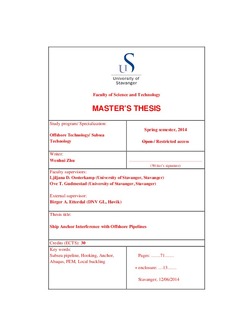| dc.contributor.author | Zhu, Wenhui | |
| dc.date.accessioned | 2015-01-12T14:53:05Z | |
| dc.date.available | 2015-01-12T14:53:05Z | |
| dc.date.issued | 2014-06-13 | |
| dc.identifier.uri | http://hdl.handle.net/11250/273975 | |
| dc.description | Master's thesis in Offshore technology | nb_NO |
| dc.description.abstract | The main purpose of this thesis was to identify and study important parameters related to hooking incidents. Criteria of local buckling in DNV-OS-F101 were used to judge the results of FE analysis acceptable or not.
In this report, several known hooking incidents were briefly described. Some aspects related to risk assessment were discussed together with some prevention approaches. Large anchors were identified to be more likely to hook a specific pipeline than small anchors. What’s more, chain length and tow velocity were discovered to decide the depth an anchor could reach.
Simulations using Abaqus were conducted to explore parameters, like magnitude of load, hooking duration, friction coefficient, which might have significant influences on the response of pipeline. In addition, a pipeline together with a chain was built in Abaqus to investigate the response of pipeline besides applying hooking load directly onto a pipeline.
The parameters studied in this thesis were all proved to affect the response of pipeline. The final configuration of pipeline by applying hooking load directly onto it was found relying on the style of load history. By setting a velocity on top of a chain, the result of FE analysis matched the survey well. Thus, efforts on adjusting the load history were avoided. Additionally, low velocities of the chain implied lower risks than high velocities.
By comparing with the local buckling criteria, responses of the pipeline with a 10m lateral displacement were found unacceptable by using LC criterion, while the responses satisfied DC criterion well. This conclusion suggested that it was not possible to design out the anchor damage by using ALS LC criterion even faced with a small anchor. Protecting pipelines in areas like anchorages and defining a failure criterion as loss of containment could be reasonable to deal with hooking incidents. | nb_NO |
| dc.language.iso | eng | nb_NO |
| dc.publisher | University of Stavanger, Norway | nb_NO |
| dc.rights | Attribution-NonCommercial-NoDerivs 3.0 Norway | * |
| dc.rights.uri | http://creativecommons.org/licenses/by-nc-nd/3.0/no/ | * |
| dc.subject | offshore teknologi | nb_NO |
| dc.subject | undervannsteknologi | nb_NO |
| dc.title | Ship anchor interference with offshore pipelines | nb_NO |
| dc.type | Master thesis | nb_NO |
| dc.subject.nsi | VDP::Technology: 500::Marine technology: 580::Offshore technology: 581 | nb_NO |

